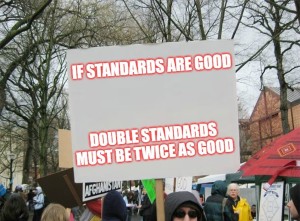Wake Up America, and Smell the Anti-Semitism
What do all these incidents have in common? Not that they are the unique province of “the right” or “the left”—but that they are happening in America on a daily basis and both the mainstream press and the organized Jewish community seem determined to ignore them. Last summer, Armin Rosen documented the “routine” attacks upon the city’s visible Jews. “The increase in the number of physical assaults against Orthodox Jews in New York City is a matter of empirical fact,” he stated, while detailing the steep rise in numbers from the NYPD hate crime unit. The question Rosen raised then was why the country’s biggest wave of hate crimes was apparently not worthy of notice by any of the city’s major newspapers, the mayor’s office, the Justice Department, or civil rights groups; six months after his article was published, it was still the only long piece on the subject.Zooming with Terror
What became clear to me from the I-405 incident is that America’s Jews don’t see anti-Semitism, even when it’s dangling over a freeway in one of its most liberal cities in broad daylight. But perhaps it isn’t odd that mainstream media haven’t reported on it when American Jews won’t admit that anti-Semitism is a real problem in this country, and when so few of our high-profile Jews speak out against such attacks. Why would the media consider it of public interest if the Jews don’t?
It seems that American Jews don’t see anti-Semitism in America because they don’t want to, not because it isn’t real. They choose not to see it because it makes them uncomfortable. Or they only see it when it comes from the other “side.”
Yet for an outsider, the normalizing of open anti-Semitism in this country on all “sides” is shocking. This past week, in addition to the Delaware Chabad, Nazi symbols were painted on a bus stop in Colorado Springs and Philadelphia’s NAACP President Rodney Muhammad was removed after posting an anti-Semitic meme to Facebook. In the past three months we’ve seen the California Board of Education go ahead with an ethnic studies curriculum that is openly anti-Semitic and anti-Israel as part of its efforts to promote diversity and understanding among cultures. Synagogues have been defaced in Pennsylvania, Boston, Florida, and Cleveland, among other places. And that’s a good week, because nobody was put in a hospital or killed.
While “anti-Zionism” provides a fig leaf for anti-Semitic bullying campaigns, especially on college campuses, the idea that there is some clear line between the new and the old types of blood libel is increasingly hard to credit in an age of hypersensitivity to every other kind of real or imagined slight. At USC, Jewish student Rose Ritch resigned from her position as vice president of the student government after being bullied for her “Zionism”—meaning her refusal to stridently condemn and disavow Israel, a subject that has zero to do with student government at the college.
At least a half dozen synagogues have been vandalized during BLM protests, including one in LA (“Fuck Israel” was sprayed on the side of the building). A BLM protest in Washington, D.C., featured the chant: “Israel, we know you, you murder children too.” There’s been a resurgence of the ugly rhetoric of Louis Farrakhan and the Nation of Islam via figures such as DeSean Jackson, P Diddy, and Jay Electronica, along with articles explaining why Louis Farrakhan is in fact a very important figure in the African American community whose minions provide young minority men with positive role models. Yikes.
Leila Khaled owes her international fame to two things: she used to hijack planes, and female hijackers remain an object of fascination. You can find her face on T-shirts, in part because some advocates of the Boycott, Divestment, and Sanctions (BDS) movement against Israel love her.The Pinnacle of Looting Apologia
As I’ve written before, that’s strange because, as Khaled has indicated any number of times, she is in favor of violence against Israel, whereas BDS sells itself as a nonviolent movement. It’s almost as if BDS isn’t dedicated to nonviolence, except as an adjunct to violence.
Khaled remains in the leadership of the Popular Front for the Liberation of Palestine (PFLP), designated a terrorist organization by the U.S. and other nations, and still very much in the terror business. A PFLP cell is suspected in a bombing that killed seventeen-year-old Israeli, Rina Shnerb, as recently as last year.
Nowadays, Khaled tours the world (when she is not denied entry) and dispenses the occasional anti-Semitic conspiracy theory.
In 2020, thanks to the magic of Zoom, San Francisco State University, whose track record on these matters is not great, can hear from Khaled without worrying about her getting stopped at the border. The event at which she will be virtually appearing is being promoted by an academic program, the cumbersomely-named Arab and Muslim Ethnicities and Diasporas Studies, which sits in SFSU’s College of Ethnic Studies. Rabab Abdulhadi, from that program, and Tomomi Kinukawa, from Women’s Studies, are co-moderators.
This event, I think, is protected by academic freedom and, at a public university like SFSU, the First Amendment. But it seems safe to assume that the co-moderators, who examined in April the “direct connections between Israeli Zionism and [a] Japanese far-right government that denies its own history of colonial violence and war-time crimes,” are not there to ask Khaled tough questions. Ethnic studies is a self-consciously politicized field that has no qualms about using the academy to promote radical politics. That’s one reason the adoption of a new ethnic studies requirement at state universities in California should be bigger news than it is.
The real story here is less the event itself—Abdulhadi and Kinukawa’s April event doesn’t seem to have generated much interest, even at San Francisco State—than the mainstreaming of this kind of thing in the academy. Abdulhadi just this year received an award from the American Association of University Professors, even though her career has been dedicated to undermining the distinction between teaching and propagandizing on which the AAUP’s defense of academic freedom relies.
I am also from recent-immigrant stock. Osterweil euphemizes looting as “proletarian shopping,” and no one from a place that has recently experienced this phenomenon can take seriously her assurance that it can happen justly and bloodlessly. When I think of riots and smashed storefronts, I think of Kristallnacht. I think of American businesses built by penniless immigrants who preferred to forfeit their vacations and weekends for 30 years rather than see their children suffer as they did; I think of these businesses ransacked in 30 minutes and left in ruins. Osterweil at least has the psychology right when she says that looting can be “joyous and liberatory.” I have never seen a sullen looter, but I have seen plenty of shop owners crying next to the smoking remains of their children’s future.
Absent from this book is even fleeting recognition that anyone (or nearly everyone) might prefer the current nonrevolutionary arrangement. Osterweil does not say what property-less system of government or anti-government she prefers, but I suspect it is not democracy, a term she uses only sneeringly. Nor is it clear how she intends to move from the past disgraces and present unrest to her goal, whatever it is, other than by rioting and stealing things until morale improves. What do you do when the free stuff runs out, the businesses and ordinary people who invested in your city decide not to make that mistake again, and—oops!—a few shopkeepers get beaten to death? This messy process is the “new world opening up, however briefly, in all its chaotic frenzy,” she writes. To me it sounds like a prequel to The Road.
Osterweil is unable or unwilling to relate to anyone at all with anything resembling a sense of humanity. Comrades and enemies alike are described without compassion, emotional detail, or distinction as people endowed with feelings or moral complexity. Once cast as a villain, a villain one remains, with no intricacies of the human condition explored under any circumstances. In the NPR interview, Osterweil describes the Los Angeles convenience store where Latasha Harlins was shot to death in 1991 as the location of “white-supremacist violence.” That shooting, which came two weeks after the beating of Rodney King and contributed to riots that killed 63 people, was perpetrated by the store owner, a female Korean immigrant—an irony that surely deserves probing. But Osterweil’s great class war has only two sides, so a working-class Korean woman is effortlessly enlisted on the side of the white-supremacist cisheteropatriarchs. Osterweil quotes a communist magazine: “Just as Jews were in 1965, Koreans in 1992 were ‘on the front-line of the confrontation between capital and the residents of central LA—they are the face of capital for these communities.’” As explanations of communal violence go, this is contemptibly inane.
Here's from the actual book "In Defense of Looting": The destruction and looting of Jewish and Korean immigrant-owned stores is justified by the author because Jews and Koreans are "the face of capital." pic.twitter.com/qPhpXQQI10
— Lee Fang (@lhfang) September 2, 2020



































.jpg)





